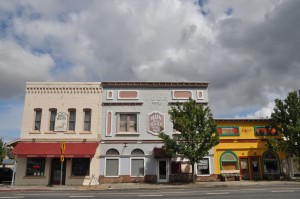My father read widely on archaeology all his years. On his bookshelves I recall a book whose title, if not its contents, fascinated me: The Mute Stones Speak. Those words capture archaeology’s fascination for me.
***

At few sites have mute stones spoken so eloquently, so originally, so importantly as at Dura Europos in the desert of eastern Syria. So proves a superb small exhibit at Boston College’s McMullen Museum, Dura Europos: Crossroads of Antiquity.
Dura Europos was less the crossroads of antiquity than a border crossing into antiquity. It sat on the Euphrates River at the eastern edge of the Roman empire. One of Alexander the Great’s companions and successors founded it in the late fourth century BCE.
Its name has had a strange resonance for me – Europos beyond Europe, I thought. Its significance is more prosaic. Europos was the Macedonian town from which came Seleucus I, founder of the Seleucid Empire. Dura meant fort. And a formidable if not impregnable one it was.
Dura Europos first came to my attention when I began reading about the calamitous third century CE when everything went wrong for the Romans. After a long siege, Dura Europos had fallen to the Sasanian Persians in 256. Digs there starting in the 1920s revealed much about the Roman army and frontier life.
***
But Dura Europos is much more significant than that to our understanding of our past, our cultural and religious history.
Like Pompeii, a substantial part of the city was buried, in this case in a desperate attempt to shore up its walls. The site was not resettled after the Sasanians took the city and dispersed any Roman survivors.
Unlike Pompeii, Dura Europos was nearly the farthest eastern reach from the center of Roman art and culture. It was certainly not a resort for cosmopolitan Romans. What remains would best be compared to what one might find of El Paso and Ft. Bliss, were they buried.
***
When American, French and Syrian archaeologists dug into the mound 1700 years later, they found, among many things, a church and a synagogue as they had been buried with unique wall paintings intact. In the case of the synagogue, the figurative decoration is like nothing found anywhere else. Both were quite small, more like houses, without significant exteriors.
The Boston College exhibit reproduces the important church and synagogue wall art. It also reproduces the wall art from a mithraeum, the hall of worship of Mithras, a divinity very popular amongst Roman legionaries.
Since Mithraism was a mystery religion, popular mainly amongst enlisted men and junior officers, scholars know very little about it. It died out with the empire’s collapse, its rebirth under Diocletian and Constantine, and the triumph of Christianity. It left no writings. Reading the history of the third century CE, in the Mithraic cult I sense an echoing of the fundamentalism pervading the American military today, most visibly at the Air Force Academy.
***
Karl Marx’s collaborator, Friedrich Engels, wrote that ‘history is about the most cruel of all goddesses, and she leads her triumphal car over heaps of corpses.’[1]
If Dura Europos signifies nothing else, it is that. Few, if any, of those who worshiped before the wall paintings likely survived the Sasanian victory. Simon James’s essay in the catalogue, ‘Dark Secrets of the Archive’ captures the desperation of the struggle revealed in the archaeological record.
The mute stones speak most eloquently, hauntingly.
***
Of the catalogue for the exhibit, Dura Europos: Crossroads of Antiquity (Boston: McMullen Museum, 2011) it is impossible to say enough. The images are superb, though I would have been happier with more of items not in the exhibit. The essays are scholarly, yet accessible. Some are written with an emotion rare in archaeological literature. And, it is beautifully produced and printed.
But – and it’s a huge but – the catalog lacks an index. So, its riches are hidden. I find this outrageous. It’s as if the publishers – scholarly publishers at that – didn’t intend the book to be used. What a place to save a few bucks on a very expensive, very important book!
***
If You Go: and you should, the Boston College campus is very poorly signed coming from the MBTA’s BC Green Line terminus. Pay no heed to the Museum’s address on the website. It is not on Commonwealth Ave.
The one thing that is signed is the BC Admissions Office which fortunately for the art lover shares the ground floor of the same building as the McMullen Museum.
Notes:
1. As quoted in Adam Kirsch, ‘He Kept Marx Going’, New York Review of Books, Oct. 22, 2009, p. 25.
Recent Comments